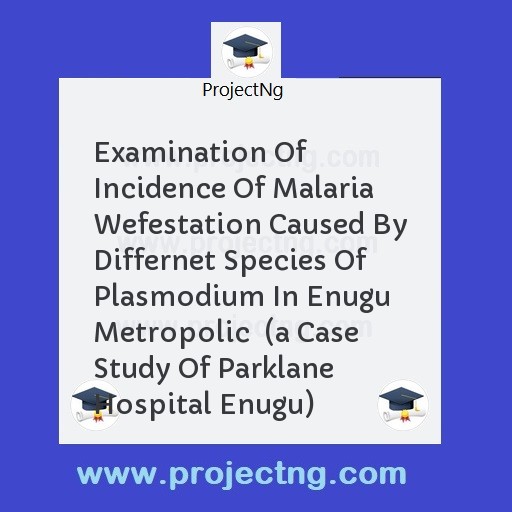Examination Of Incidence Of Malaria Wefestation Caused By Differnet Species Of Plasmodium In Enugu Metropolic (a Case Study Of Parklane Hospital Enugu)
Science Lab Technology Project Topics
Get the Complete Project Materials Now! »
EXAMINATION OF INCIDENCE OF MALARIA WEFESTATION CAUSED BY DIFFERNET SPECIES OF PLASMODIUM IN ENUGU METROPOLIC
(A CASE STUDY OF PARKLANE HOSPITAL ENUGU)
ABSTRACT
The incidence of the infestation of plasmodium species (P.Falciparum, P. Vivax, P.Ovale, and P. alaria) which causes human malaria in Enugu metropolis was conducted at Parklane Hospital using their patients. Thick and thin, smear of blood were made and examined after proper staining. The staining method which proved effective were the Giemsa and Liesman staining method. It was observed that P.Falciparum was most prevalent of the fair species while P.Ovale has occuarence. The report from P.Malaria and P.Ovale were not significant to be recorded. Prevalent is higher in children than in Adult.
TABLE OF COSNTENTS
Title page
Certification
Dedication
Acknowledgement
Abstract
Table of contents
CHAPTER ONE
1.0 Introduction
1.1 Aim and Objective
1.2 Statement of problem
1.3 Hypothesis
1.4 Justification
1.5 Limitation of the study
1.6 Scope of the study
CHAPTER TWO
2.0 Literature review
2.1 The parasite
2.2 Plasmodium species and their distributions
2.3 Clinical features and pathology of the species
2.4 The transmission Dynamics/Life cycle
2.5 Differences in Plasmodium species
CHAPTER THREE
Material and method
3.0 Materials
3.1 Procurement of sample
3.2 Stock solution
3.3 Technique of staining thick films using Giensa stain
3.4 Technique of stain of thin film using Leisman stain
CHAPTER FOUR
4.0 Results and data collection
4.1 Results
4.2 Comparism of incidence of malaria
4.3 Data Analysis
CHAPTER FIVE
5.0 Discussion, Recommendation and Conclusion
5.1 Discussion
5.2 Recommendation
5.3 References
LIST OF TABLE
Pages
Table 1: Differences in plasmodium species 29
Table 2: Age distribution of target population 35
Table 3: Sex distribution of the incidence of malaria
on the first day 35
Table 4: Comparison of the incidence of malaria by
species of plasmodium 36
Table 5: Sex distribution of the incidence of malaria
on the second day 36
LIST OF FIGURES
Figure 1: The life cycle of malaria parasite 3
Figure 2: Diagram of thick and thin film 27
Figure 3: The Gametocyte of P. Vicax and P.Ovale 31
Figure 4: The trophozoite of P. Vivax and P. Ovale 32
Figure 5; The trophozoite of P. Malaria and P falaparum 33
Figure 6: The Gametocyte of P. malaria and P falciparum 34
Figure 7: Graph showing incidence of malaria By species
of plasmodium on the first day using table one 37
Figure 8: Barchart showing incidenced of malaria by
species of Plasmodium on the first day using
table one 38
Figure 9: Sex distribution of the incidence of malaria
on the first day using table 2 39
Figure 10: Graph showing the incidence of malaria on the
second day using table 3 40
CHAPTER ONE
1.0 THE BACKGROUND INFORMATION
Malaria is a febrile illness caused by a protozoan of the germs plasmodium present public health problem and cause suffering and premature death in tropical and subtropical countries, because of htier ample rainfall; and long periods, of warmth which favour both mosquito breeding and human infection (Adams and Magraitt 1980,),
In many endemic area, malaria increases and difficult to control because of the resistance of the parasite to antimalaria drings and the failure of vector control measures: At present, about two billion population live in malarious zone. Every year, 200-300 million people are due to the disease. Most of the victims are children under five (5) and pregnant women in areas of stable malaria (intence malaria) transmission. Malaria also poses a risk to travellers, tarists and immigrants and exotic cases of malaria are
There are four species of Plasmodium which infects humans. although infection is generally cases occur in the USA and other countries which are otherwise free of malaria transmission. Falciparum, and Plasmodium vivaz, which are found throughout malaria belt. Plasmodium malaria is widely distributed but less common Plasmodium Ovale is rare but it tends to replace P. Viax in west Africa where it has been linked with Lack of Duffy blood group by (John Murray, 1880).
The life cycle of the malaria (Plasmodium protozoa) includes of the malaria (plasmodium protozoa)includes three basic stages. The first stage occurs in the mosgintos body (Exogenous stage). The second and the third stages take place in a persons body (exogenous stage) the first stage begins where the mosginto bites Samoan who has malaria. Plasmodium enter the insects body and reproduce in its stomach. The protozoan young tin their way into the mosguito saliva. The second stage occurs after the mosquito bites another person. Plasmodia.
Be the First to Share On Social

Enjoying our content?
Don't miss out on new videos! Subscribe to our YouTube channel for more awesome content.
Subscribe Now!













